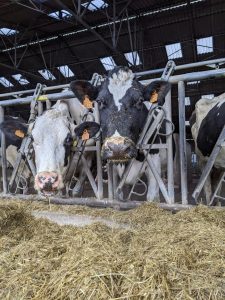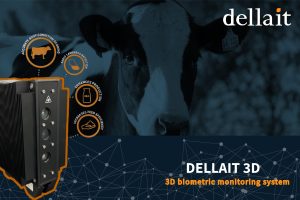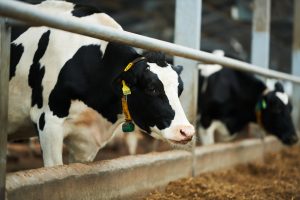Álvaro García
Ruminal acidosis is one of the most economically damaging and frequently overlooked disorders in high-producing dairy herds. According to the USDA-APHIS Dairy 2007 study, subacute ruminal acidosis (SARA) can affect a large proportion of lactating cows, often without any obvious clinical signs (USDA-APHIS 2007). The resulting subclinical symptoms, including decreased milk yield, low milk fat, lameness, and digestive disturbances, can silently erode profitability. In affected herds, daily losses may exceed $1.12 per cow due to reduced production efficiency, increased veterinary interventions, and higher culling rates.
The root of the issue lies in the energy demands of modern dairy cows. To sustain high levels of milk production, cows are fed diets rich in rapidly fermentable carbohydrates. While these diets meet performance targets, they often do so at the expense of rumen stability. When acid production outpaces buffering capacity, rumen pH drops, setting the stage for acidosis. Understanding both the biological mechanisms and economic consequences of this disorder is key to managing it effectively.
What causes it?
At the core of ruminal acidosis is an imbalance between acid production and the rumen’s ability to buffer it. When cows consume large amounts of fermentable carbohydrates, such as finely ground grains, molasses, or bakery byproducts, the microbial population shifts toward acid-producing bacteria, including Streptococcus bovis and Lactobacillus spp. These bacteria generate lactic acid, which sharply lowers rumen pH. As acidity increases, beneficial fiber-digesting microbes decline, making the rumen even more vulnerable to fermentation disturbances.
Acidosis typically presents in two forms:
- Subacute ruminal acidosis (SARA) is more common and insidious. Defined by rumen pH levels between 5.2 and 5.6 for extended periods, SARA doesn’t cause immediate death but leads to chronic production losses and health problems.
- Acute acidosis occurs when rumen pH drops below 5.0 after a sudden overload of carbohydrates. This can cause systemic acidosis, dehydration, and, in extreme cases, death.
The feeding connection
Feeding strategies have a profound impact on acidosis risk. It’s important to recognize that subclinical ruminal acidosis isn’t limited to confinement-fed animals. Grazing cows, especially those on lush, early vegetative pasture, can also be at risk. These forages are highly fermentable and low in fiber, and when combined with supplemental grain, they can lead to excessive production of volatile fatty acids and a drop in rumen pH. This often-overlooked scenario shows that acidosis can occur even under what appear to be “natural” grazing conditions, particularly in high-producing herds.
Small feed particles pose a similar challenge. Overprocessed silages and finely ground grains pass quickly through the rumen, providing little rumination stimulus. Reduced chewing leads to less saliva production, which diminishes the rumen’s natural buffering capacity.
This is where physically effective neutral detergent fiber (peNDF) becomes critical. Unlike just “any fiber,” peNDF has the right length and texture to promote chewing and maintain a rumen mat. This mat holds feed in the rumen longer, moderates’ fermentation, and supports microbial balance.
High-energy ingredients like corn, barley, or wheat are necessary for peak performance, but without enough effective fiber to offset them, they can tip the rumen into an acidotic state.
Certain feedstuffs, while lacking physically effective fiber due to their small particle size, still exert what can be called an “effective fiber effect” by promoting rumen stability through other mechanisms. Beet pulp and soyhulls, for example, are highly digestible fiber sources that do not stimulate much rumination, yet they shift the rumen fermentation pattern toward increased acetate and reduced propionate and lactic acid production. This helps stabilize rumen pH despite their limited contribution to physically effective fiber. Similarly, distillers dried grains with solubles (DDGS) provide a high-energy feed option without contributing to the rapid fermentation associated with starch, thereby lowering the risk of subacute ruminal acidosis. Cottonseeds, while also low in structural fiber length, promote chewing activity, which increases saliva flow and enhances the rumen’s natural buffering capacity. Together, these feeds demonstrate that rumen health can be supported not only through particle size but also through shifts in volatile fatty acid profiles and enhanced salivation, offering practical alternatives in managing acidosis risk (Garcia 2025).
Understanding the risk and impact of ruminal acidosis
Several interrelated factors contribute to the risk of ruminal acidosis. High-starch, low-fiber diets are the primary culprit, as they ferment rapidly and lower rumen pH. Poor feeding management, such as irregular feeding schedules, inconsistent TMR mixing, or limited bunk space, can lead to erratic intake, further destabilizing rumen conditions. The transition from dry to lactation diets also increases vulnerability, since cows need time to adapt to the higher fermentable load. Particle size matters too; finely ground feeds don’t stimulate chewing or saliva production, reducing the natural buffering that helps maintain rumen stability.
Diagnosing subacute ruminal acidosis (SARA) is challenging, as cows often appear clinically normal even when rumen pH is dangerously low for several hours. While direct pH measurement through rumenocentesis or stomach tubing is possible, results vary depending on timing and sampling location. More practical are indirect signs such as loose manure, reduced cud-chewing, lower milk fat content, or a milk fat-to-protein ratio under 1.2. Increasingly, pH boluses that transmit real-time data are being used to reveal hidden pH fluctuations in seemingly healthy cows.
When left unchecked, SARA has widespread consequences. Milk yield and fat percentage typically decline, and inflammation in the rumen can lead to liver abscesses, laminitis, and systemic health issues. Fertility may suffer as well, due to the chronic metabolic stress that disrupts hormone balance and delays reproductive cycles.
Prevention
Preventing acidosis requires a comprehensive approach, beginning with well-balanced rations that provide enough physically effective fiber and avoid excess fermentable starch. Transitioning diets gradually post-calving gives rumen microbes time to adapt. Feeding practices must be consistent, with a stable TMR and minimal sorting or bunk emptying. In addition:
- Feed additives like buffers, such as sodium bicarbonate and magnesium oxide, can enhance the rumen’s buffering capacity and improve fiber digestion when used together (Garcia 2025b). Yeast cultures and direct-fed microbials also play a role in stabilizing pH.
- Cow comfort is critical, adequate space and low competition at the feed bunk promote steady intake and reduce feeding stress.
- Monitoring tools, such as automated feeders and wireless pH sensors, offer early warning signs and allow for timely adjustments.
Implications
Recent reviews, including the one by Golder and Lean (2023), argue that pH thresholds alone are insufficient to define or diagnose acidosis. Instead, they recommend a broader diagnostic framework that includes fermentation end-products, microbial profiles, and animal-level performance outcomes. This holistic view reflects the complexity and variability of rumen responses to diet.
Ruminal acidosis is more than just a metabolic disorder, an economic threat and a barrier to long-term herd productivity. Preventing it isn’t about eliminating energy from the diet but about striking the right balance between fermentability and fiber. With a deeper understanding of feed structure, rumen microbiology, and cow behavior, both farmers and nutritionists can build diets that support performance without compromising rumen health.
© 2025 Dellait Knowledge Center. All Rights Reserved.









